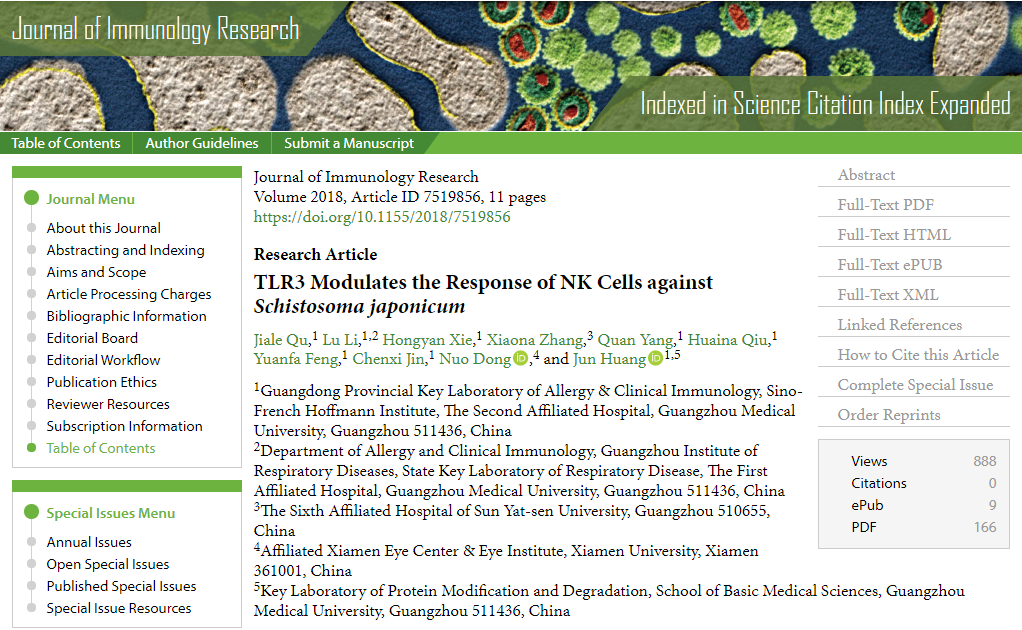
Journal of Immunology Research, 30 August 2018, DOI: https://doi.org/10.1155/2018/7519856
TLR3 Modulates the Response of NK Cells against Schistosoma japonicum
Jiale Qu, Lu Li, Hongyan Xie, Xiaona Zhang, Quan Yang, Huaina Qiu, Yuanfa Feng, Chenxi Jin, Nuo Dong, and Jun Huang
1Guangdong Provincial Key Laboratory of Allergy & Clinical Immunology, Sino-French Hoffmann Institute, The Second Affiliated Hospital, Guangzhou Medical University, Guangzhou 511436, China
2Department of Allergy and Clinical Immunology, Guangzhou Institute of Respiratory Diseases, State Key Laboratory of Respiratory Disease, The First Affiliated Hospital, Guangzhou Medical University, Guangzhou 511436, China
3The Sixth Affiliated Hospital of Sun Yat-sen University, Guangzhou 510655, China
4Affiliated Xiamen Eye Center & Eye Institute, Xiamen University, Xiamen 361001, China
5Key Laboratory of Protein Modification and Degradation, School of Basic Medical Sciences, Guangzhou Medical University, Guangzhou 511436, China
Correspondence should be addressed to Nuo Dong; profeye@163.com and Jun Huang; hj165@sina.com
Abstract
Natural killer (NK) cells are classic innate immune cells that play roles in many types of infectious diseases. NK cells possess many kinds of TLRs that allow them to sense and respond to invading pathogens. Our previous study found that NK cells could modulate the immune response induced by Schistosoma japonicum (S. japonicum) in C57BL/6 mice. In the present study, the role of TLRs in the progress of S. japonicum infection was investigated. Results showed that the expression of TLR3 on NK cells increased significantly after S. japonicum infection by using RT-PCR and FACS (). TLR3 agonist (Poly I:C) increased IFN-γ and IL-4 levels in the supernatant of cultured splenocytes and induced a higher percentage of IFN-γ- and IL-4-secreting NK cells from infected mouse splenocytes (). Not only the percentages of MHC II-, CD69-, and NKG2A/C/E-expressing cells but also the percentages of IL-4-, IL-5-, and IL-17-producing cells in TLR3+ NK cells increased significantly after infection (). Moreover, the expression of NKG2A/C/E, NKG2D, MHC II, and CD69 on the surface of splenic NK cells was changed in S. japonicum-infected TLR3−/− (TLR3 KO mice, ); the abilities of NK cells in IL-4, IL-5, and IL-17 secretion were decreased too (). These results indicate that TLR3 is the primary molecule which modulates the activation and function of NK cells during the course of S. japonicum infection in C57BL/6 mice.
Link:https://www.hindawi.com/journals/jir/2018/7519856/